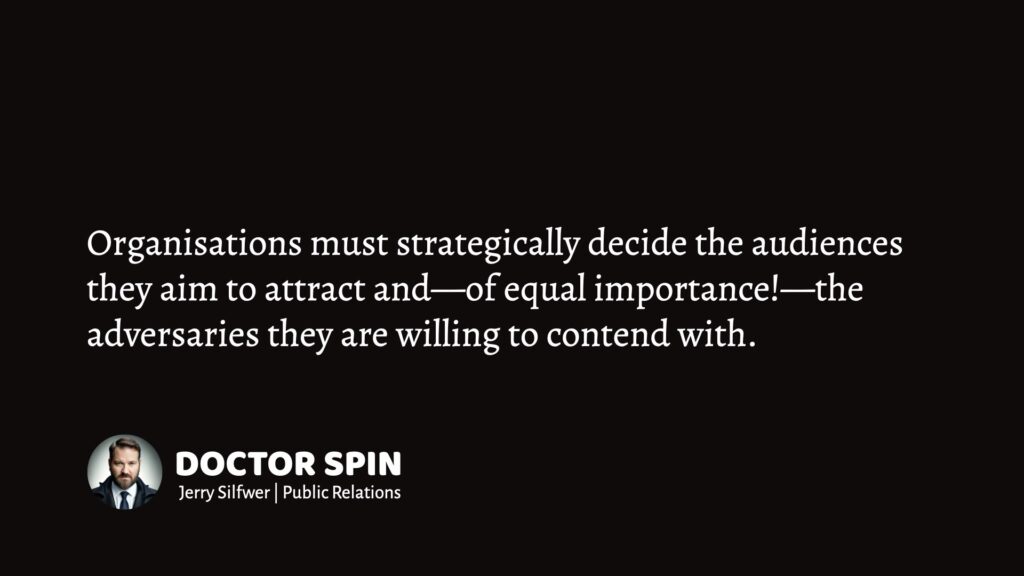Be mindful of the paradox of prominence.
With every increase in visibility, there is a corresponding increase in criticism. To make matters more complicated, it’s what earns you that recognition that also becomes the target of scrutiny.
It’s the paradox of prominence.
Here we go:
The Paradox of Prominence
The “dark side” of what drives people’s engagement can be a true PR challenge. This phenomenon, where every strength inherently possesses a corresponding downside, can be called the paradox of prominence.

An example of this paradox is the halo effect, where physical attractiveness becomes an asset for a spokesperson. Attractiveness often leads to positive biases; attractive individuals are frequently perceived as more credible and competent. 1Eagly, A. H., Ashmore, R. D., Makhijani, M. G., & Longo, L. C. (1991). What is beautiful is good, but…: A meta-analytic review of research on the physical attractiveness stereotype. … Continue reading 2Silfwer, J. (2023, December 17). The Halo Effect: Why Attractiveness Matters in PR. Doctor Spin | The PR Blog. https://doctorspin.net/halo-effect/
However, this same attribute can spark negative reactions. Critics might claim that the individual’s success or visibility is primarily due to their looks, undermining their competencies. This duality illustrates how the qualities that draw positive attention can simultaneously attract criticism and scepticism.
Competence, another valuable trait, often encounters similar pitfalls. Highly competent individuals inspire confidence and admiration. Nevertheless, this competence can be perceived negatively when willfully interpreted as arrogance. Studies suggest that while competence garners respect, it can also lead to social penalties, such as envy and resentment. 3Fiske, S. T., Cuddy, A. J. C., Glick, P., & Xu, J. (2002). A model of (often mixed) stereotype content: Competence and warmth respectively follow from perceived status and competition. Journal of … Continue reading
Examples of the Paradox of Prominence
The paradox of prominence seems to be an inherent aspect of human interest dynamics.
| Prominence | Positive Outcome | Negative Outcome |
|---|---|---|
| Physical attractiveness | Enhanced credibility and trust | Accusations of superficial success |
| High competence | Respected and trusted as an expert | Perceived as arrogant or unapproachable |
| Charisma | Ability to inspire and attract followers | Viewed as manipulative or insincere |
| Strong advocacy | Increased support and mobilization for a cause | Target of intense criticism from opponents |
| Wealth | Seen as successful and influential | Resentment and accusations of greed or unfairness |
| Assertiveness | Effective leadership and decision-making | Labeled as domineering or aggressive |
| Innovation | Admired for creativity and forward-thinking | Resistance to change and criticism from traditionalists |
| High visibility | Greater recognition and influence | Increased scrutiny and loss of privacy |
| Generosity | Viewed as kind-hearted and philanthropic | Suspected of ulterior motives |
| Success in competitive fields | Role model and symbol of achievement | Envy and attempts to undermine accomplishments |
We must recognise that with every increase in visibility, there is a corresponding increase in scrutiny and criticism.
“Being Loved by Everyone”
Earning public awareness comes with inevitable costs.
In the quest for greater visibility and influence, it is critical to acknowledge that “being universally well-liked” is a naïve and unrealistic goal.
“Being loved by everyone” can never be a viable public relations strategy.
By strategically harnessing this paradox, public relations professionals can manage public perception by internalising expected “downsides” as additional awareness drivers.
Learn more: The Paradox of Prominence
The Halo Effect
In public relations, understanding and strategically using psychological phenomena can be the key to successful campaigns. One such phenomenon, the halo effect, plays a profound role in shaping public perception.
Perhaps you’ve heard of pretty privilege?
The halo effect occurs when our overall impression of a person influences our judgments of their specific traits. The effect extends beyond individual assessments and significantly impacts marketing strategies where singular characteristics often shape consumer perceptions of advertisements and brands.
“The halo effect occurs when a person’s overall positive traits influence our evaluations of individual attributes, leading to unconscious biases in judgments.”
Source: Journal of Personality and Social Psychology 4Nisbett, R., & Wilson, T. (1977). The halo effect: Evidence for unconscious alteration of judgments. Journal of Personality and Social Psychology, 35, … Continue reading
Learn more: The Halo Effect
“Grey” is Not the Way
One might argue that mitigating the potential downsides by toning down your prominence is a viable solution. However, this approach would result in a mediocre presentation at best — one that fails to capture attention or make a significant impact.
“Vanilla” messaging, filtered internally to sleep-inducing mediocrity, is the very last thing corporate communication needs.
The essence of the paradox of prominence lies in this delicate balance: striving for visibility and influence inevitably invites scrutiny and criticism. This duality is not a “problem” per se — it’s your inherent “contradiction friction” makes you more attractive.
The Anatomy of Attention
Attention is an essential component of public relations:
An organisation, starved of attention, trust, and loyalty, is compelled to wage a perpetual struggle for its continued existence.
And it’s not just organisations. We all seem to crave attention in some form or another:
“People want to be loved; failing that admired; failing that feared; failing that hated and despised. They want to evoke some sort of sentiment. The soul shudders before oblivion and seeks connection at any price.”
— Hjalmar Söderberg (1869−1941), Swedish author
It’s fear of social isolation—and attention starvation.
“There’s only one thing in the world worse than being talked about, and that is not being talked about.”
— Oscar Wilde
Types of Attention
But what constitutes ‘attention’?
“Attention is a complex, real neural architecture (‘RNA’) model that integrates various cognitive models and brain centers to perform tasks like visual search.”
Source: Trends in cognitive sciences 5Shipp, S. (2004). The brain circuitry of attention. Trends in Cognitive Sciences, 8, 223 – 230. https://doi.org/10.1016/j.tics.2004.03.004
Each of the below terms refers to a specific aspect or type of attention (“mental bandwidth”), a complex cognitive process. 6Schweizer, K., Moosbrugger, H., & Goldhammer, F. (2005). The structure of the relationship between attention and intelligence. Intelligence, 33(6), 589 – 611. … Continue reading
Let’s explore different types of attention:
Each type of attention is likely to play a role in how we interact with and process information from our environment, and understanding these different aspects is key in fields like psychology, neuroscience, and education.
Learn more: The Anatomy of Attention

THANKS FOR READING.
Need PR help? Hire me here.

What should you study next?
Spin Academy | Online PR Courses

Spin’s PR School: Free Psychology PR Course
Join this free Psychology PR Course to learn essential skills tailored for public relations professionals. Start now and amplify your impact on society today.
Psychology in Public Relations
Group Psychology
Learn more: All Free PR Courses
💡 Subscribe and get a free ebook on how to get better PR.

Annotations
| 1 | Eagly, A. H., Ashmore, R. D., Makhijani, M. G., & Longo, L. C. (1991). What is beautiful is good, but…: A meta-analytic review of research on the physical attractiveness stereotype. Psychological Bulletin, 110(1), 109 – 128. https://doi.org/10.1037/0033 – 2909.110.1.109 |
|---|---|
| 2 | Silfwer, J. (2023, December 17). The Halo Effect: Why Attractiveness Matters in PR. Doctor Spin | The PR Blog. https://doctorspin.net/halo-effect/ |
| 3 | Fiske, S. T., Cuddy, A. J. C., Glick, P., & Xu, J. (2002). A model of (often mixed) stereotype content: Competence and warmth respectively follow from perceived status and competition. Journal of Personality and Social Psychology, 82(6), 878 – 902. https://doi.org/10.1037/0022 – 3514.82.6.878 |
| 4 | Nisbett, R., & Wilson, T. (1977). The halo effect: Evidence for unconscious alteration of judgments. Journal of Personality and Social Psychology, 35, 250 – 256. https://doi.org/10.1037/0022 – 3514.35.4.250 |
| 5 | Shipp, S. (2004). The brain circuitry of attention. Trends in Cognitive Sciences, 8, 223 – 230. https://doi.org/10.1016/j.tics.2004.03.004 |
| 6 | Schweizer, K., Moosbrugger, H., & Goldhammer, F. (2005). The structure of the relationship between attention and intelligence. Intelligence, 33(6), 589 – 611. https://doi.org/10.1016/j.intell.2005.07.001 |


